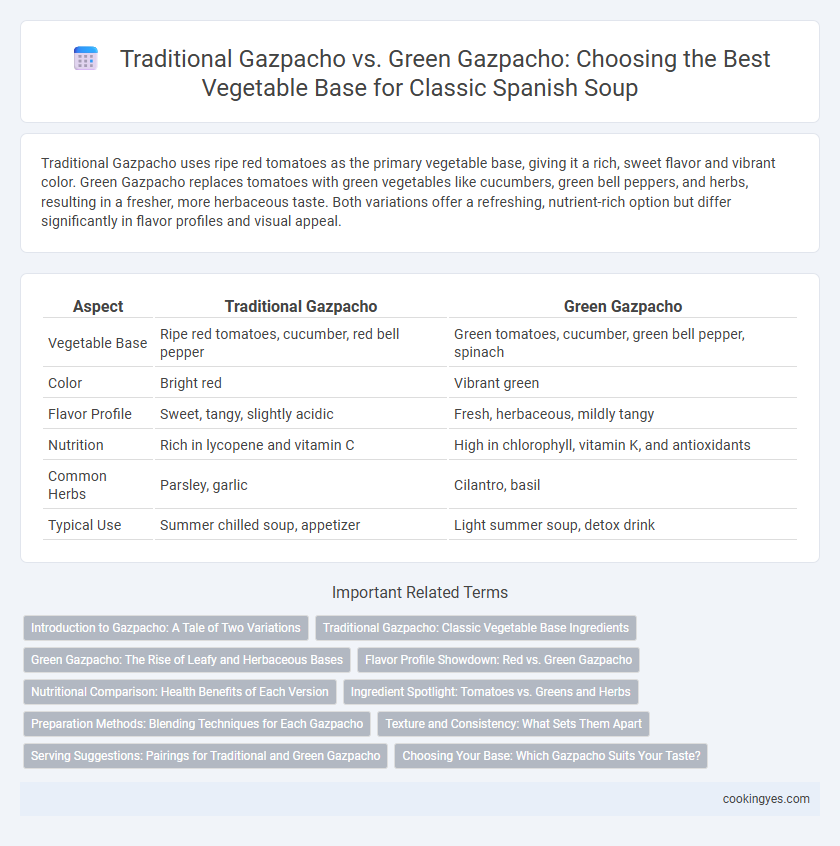Traditional Gazpacho uses ripe red tomatoes as the primary vegetable base, giving it a rich, sweet flavor and vibrant color. Green Gazpacho replaces tomatoes with green vegetables like cucumbers, green bell peppers, and herbs, resulting in a fresher, more herbaceous taste. Both variations offer a refreshing, nutrient-rich option but differ significantly in flavor profiles and visual appeal.
Table of Comparison
| Aspect | Traditional Gazpacho | Green Gazpacho |
|---|---|---|
| Vegetable Base | Ripe red tomatoes, cucumber, red bell pepper | Green tomatoes, cucumber, green bell pepper, spinach |
| Color | Bright red | Vibrant green |
| Flavor Profile | Sweet, tangy, slightly acidic | Fresh, herbaceous, mildly tangy |
| Nutrition | Rich in lycopene and vitamin C | High in chlorophyll, vitamin K, and antioxidants |
| Common Herbs | Parsley, garlic | Cilantro, basil |
| Typical Use | Summer chilled soup, appetizer | Light summer soup, detox drink |
Introduction to Gazpacho: A Tale of Two Variations
Traditional gazpacho features a vegetable base primarily composed of ripe tomatoes, cucumbers, bell peppers, garlic, and olive oil, offering a rich red hue and classic tangy flavor. In contrast, green gazpacho utilizes green tomatoes or tomatillos, cucumbers, green bell peppers, and fresh herbs like parsley or cilantro, delivering a vibrant green color and a fresher, herbaceous taste. Both variations highlight the raw vegetable essence but cater to different flavor profiles and regional preferences within Spanish cuisine.
Traditional Gazpacho: Classic Vegetable Base Ingredients
Traditional gazpacho features a vegetable base primarily composed of ripe tomatoes, cucumbers, bell peppers, onions, and garlic, blended together to create a refreshing and vibrant soup. The classic combination relies on the natural sweetness of tomatoes and the crispness of cucumbers to balance flavors, often enhanced with olive oil, vinegar, and bread for texture. This time-honored recipe emphasizes fresh, garden vegetables that reflect the authentic taste and heritage of Andalusian cuisine.
Green Gazpacho: The Rise of Leafy and Herbaceous Bases
Green gazpacho emphasizes leafy greens like spinach, kale, and parsley as its vegetable base, offering a fresher and herbaceous profile compared to traditional tomato-based gazpacho. This variation enhances nutritional value with increased chlorophyll, vitamins A and K, and antioxidants, catering to health-conscious consumers. The rise of green gazpacho reflects a growing trend toward plant-forward diets and innovative uses of seasonal herbs and leafy vegetables.
Flavor Profile Showdown: Red vs. Green Gazpacho
Traditional red gazpacho features a robust, tangy flavor derived from ripe tomatoes, garlic, and red bell peppers, offering a refreshing yet intense taste. Green gazpacho highlights a fresher, herbaceous profile dominated by green vegetables like cucumbers, green tomatoes, and herbs such as parsley or cilantro, resulting in a lighter, more vibrant flavor. The flavor profile showdown reveals red gazpacho as bold and heartier, while green gazpacho delivers crisp, grassy notes ideal for those seeking a milder, vegetal taste.
Nutritional Comparison: Health Benefits of Each Version
Traditional gazpacho, made primarily from ripe tomatoes, cucumbers, bell peppers, and garlic, is rich in antioxidants like lycopene, vitamin C, and fiber, which support heart health and reduce inflammation. Green gazpacho, using green vegetables such as cucumbers, green bell peppers, parsley, and avocado, offers higher levels of chlorophyll, vitamin K, and healthy fats that promote detoxification and enhance nutrient absorption. Both versions provide low calories and hydrating properties but differ in nutrient profiles that cater to distinct health benefits, making each suitable for varying dietary needs.
Ingredient Spotlight: Tomatoes vs. Greens and Herbs
Traditional gazpacho centers on ripe tomatoes, which provide a vibrant red hue, natural sweetness, and rich umami that forms the soup's characteristic base. Green gazpacho replaces tomatoes with leafy greens such as spinach, cucumber, and fresh herbs like cilantro or basil, resulting in a fresher, earthier flavor profile packed with chlorophyll and antioxidants. While traditional gazpacho emphasizes the juiciness and acidity of tomatoes, green gazpacho highlights nutrient-dense greens for a lighter, herbaceous alternative.
Preparation Methods: Blending Techniques for Each Gazpacho
Traditional gazpacho relies on coarse blending techniques to retain a chunky texture, mixing ripe tomatoes, cucumbers, and peppers into a rustic base. Green gazpacho employs smoother blending methods, often incorporating herbs like basil and spinach for a vibrant, creamy consistency. The variation in blending intensity highlights the textural and flavor contrasts between the red and green vegetable bases in these refreshing soups.
Texture and Consistency: What Sets Them Apart
Traditional gazpacho features a smooth, slightly chunky texture achieved by blending ripe red tomatoes, cucumbers, bell peppers, and stale bread soaked in olive oil and vinegar, resulting in a thicker and heartier consistency. Green gazpacho uses crisp green vegetables like cucumbers, green bell peppers, and herbs such as parsley and cilantro, creating a lighter, fresher texture that is often more liquid and less dense. The difference in vegetable base directly influences the mouthfeel, with traditional gazpacho offering richness and body while green gazpacho emphasizes a vibrant, refreshing consistency.
Serving Suggestions: Pairings for Traditional and Green Gazpacho
Traditional gazpacho, made from ripe red tomatoes, bell peppers, cucumbers, and garlic, pairs excellently with crusty bread, cured ham, and hard cheeses like Manchego, highlighting its rich, savory flavor. Green gazpacho, featuring ingredients such as green tomatoes, cucumbers, herbs, and avocados, complements fresh seafood, grilled chicken, and tangy goat cheese, enhancing its bright and herbaceous profile. Both versions benefit from chilled serving temperatures and garnishes that include diced vegetables, herbs, and a drizzle of extra virgin olive oil for added texture and flavor contrast.
Choosing Your Base: Which Gazpacho Suits Your Taste?
Traditional gazpacho features a tomato-based vegetable blend that delivers a rich, tangy flavor packed with antioxidants like lycopene and vitamin C. Green gazpacho uses cucumbers, green peppers, and herbs such as parsley and cilantro to create a fresher, lighter base rich in vitamins K and A. Selecting between these gazpachos depends on whether you prefer a robust, classic Mediterranean taste or a refreshing, herbaceous profile ideal for cooling summer meals.
Traditional Gazpacho vs Green Gazpacho for Vegetable Base Infographic

 cookingyes.com
cookingyes.com